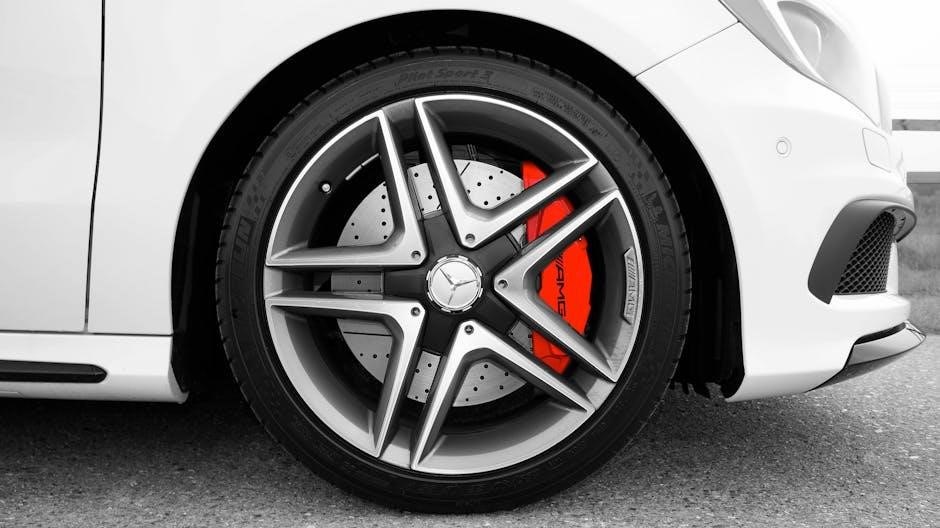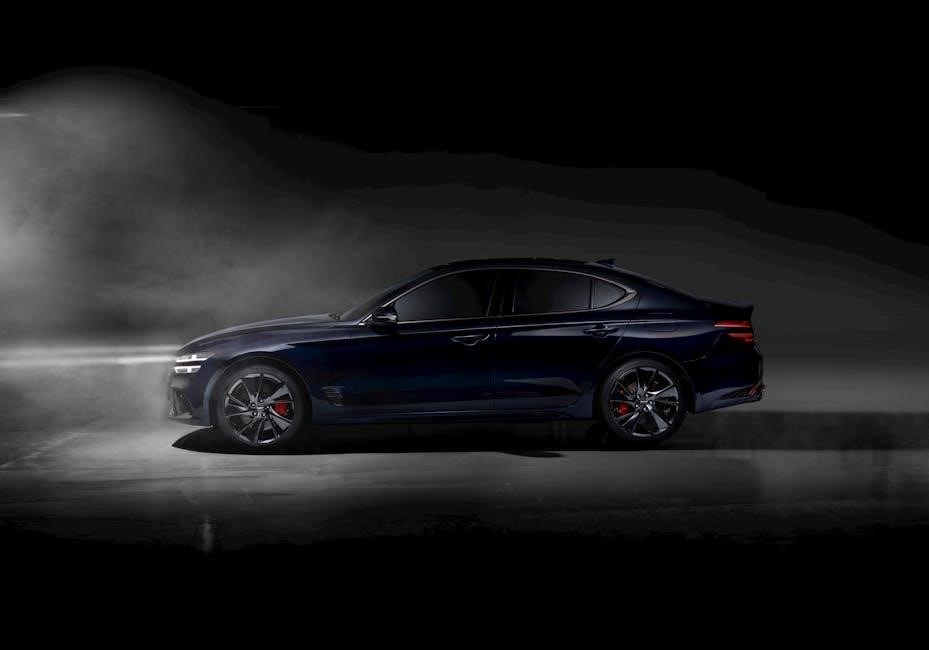Manual Brakes vs Power Brakes: A Comprehensive Comparison
Manual and power brakes differ significantly in operation, efficiency, and driver effort. Understanding their mechanisms, advantages, and limitations is crucial for making informed decisions based on specific needs and preferences.
Manual brakes rely on mechanical linkages and the driver’s physical effort to apply pressure to the brake pads or shoes. Power brakes, on the other hand, use a booster, typically vacuum-assisted, to reduce the effort needed to press the pedal. Manual systems are simpler, with fewer components, while power brakes incorporate additional parts like the booster and servo to enhance performance. Both systems aim to slow or stop the vehicle but differ in complexity, driver input, and braking efficiency. Understanding these foundational differences is essential for evaluating their pros and cons in various driving scenarios.
Key Differences: Manual vs Power Brakes
The primary distinction lies in the mechanism and effort required. Manual brakes operate solely through mechanical linkages, demanding more physical force from the driver, while power brakes use a vacuum or hydraulic booster to reduce pedal effort. Manual systems are simpler, with fewer components, whereas power brakes incorporate additional parts like the booster, increasing complexity. The pedal feel also differs: manual brakes offer a more direct, tactile response, while power brakes provide a softer, less labor-intensive experience. These differences significantly impact braking performance, driver comfort, and overall vehicle handling, making them suited for different driving scenarios and preferences.

Advantages of Manual Brakes
Manual brakes offer simplicity, reliability, and lower costs, making them ideal for lightweight vehicles. They provide direct control and a tactile feel, appealing to drivers who value precision and connection to their car’s mechanics, enhancing the driving experience with a more engaged and precise braking system.
Simplicity and Reliability
Manual brakes are renowned for their straightforward design, with fewer components compared to power-assisted systems. This simplicity reduces the risk of mechanical failure and eliminates reliance on external power sources like engine vacuum. Drivers appreciate the consistent, predictable braking performance, especially in lightweight vehicles. The absence of complex parts also means less maintenance and lower repair costs over time. Additionally, manual brakes are less prone to issues caused by component failures, making them a reliable choice for drivers seeking durability and ease of use without the need for advanced technology.
Cost-Effectiveness
Manual brakes are generally more cost-effective than power brakes, as they lack the additional components required for power assistance, such as vacuum boosters and sensors. This simplicity reduces both installation and maintenance costs, making manual brakes a budget-friendly option for many drivers. Additionally, the absence of complex electronics means fewer parts to replace over time, leading to long-term savings. Manual brakes are particularly cost-efficient for lightweight vehicles or those with lower braking demands, where the added expense of power brakes may not be justified. This makes them an attractive choice for drivers prioritizing affordability without compromising essential braking functionality.
Better Control and Feel
Manual brakes offer a more direct connection to the braking system, providing drivers with better tactile feedback and control. Without the assistance of a power booster, the pedal feel is more responsive, allowing drivers to precisely modulate braking force. This makes manual brakes particularly advantageous for drivers who value a more engaging and precise driving experience. The direct mechanical link ensures consistent braking performance, especially in lightweight vehicles or scenarios where fine control is essential. This responsiveness is a key reason why manual brakes are often preferred by enthusiasts and drivers seeking a more connected feel behind the wheel.

Advantages of Power Brakes
Power brakes reduce driver effort, enhance braking performance, and provide consistent stopping power. They are ideal for modern vehicles, offering improved safety and efficiency in various driving conditions.

Reduced Driver Effort
Power brakes significantly reduce the physical effort required by drivers, especially in heavy traffic or frequent stopping scenarios. By utilizing a brake booster, they amplify pedal pressure, making braking easier and less tiring. This feature is particularly beneficial for drivers with limited leg strength or stamina. The reduced effort allows drivers to maintain control and focus on steering, enhancing overall driving safety and comfort. This advantage is especially noticeable in modern vehicles, where power brakes have become a standard feature to improve drivability and reduce driver fatigue.
Improved Braking Performance
Power brakes deliver superior braking performance by providing faster and more consistent stops, especially under heavy load or high-speed conditions. The brake booster allows for precise control and increased stopping power, reducing the risk of brake fade over repeated use. This results in shorter stopping distances and improved safety. Additionally, power brakes are more responsive, enabling drivers to react quickly in emergencies. The enhanced performance makes them ideal for vehicles requiring reliable and efficient braking systems, ensuring better control and safety on the road compared to manual brakes.
Modern Vehicle Compatibility
Modern vehicles predominantly utilize power brakes due to their compatibility with advanced systems. Power brakes seamlessly integrate with features like ABS and ESP, enhancing safety and control. In contrast, manual brakes, while reliable, lack this integration and are less suited for the complex demands of modern automotive technology. While it’s possible to install manual brakes, doing so often requires extensive modifications, which can complicate the braking system and affect reliability. This makes power brakes more practical for contemporary vehicles, as they align with current automotive engineering and safety standards.
Disadvantages of Manual Brakes
Manual brakes require increased driver effort, have longer pedal travel, and may lack the performance needed for modern vehicles, making them less practical for everyday driving demands.
Increased Driver Effort
Manual brakes require significantly more driver effort compared to power brakes, as they lack the assistance of a brake booster. Without the booster, the pedal must be pressed with greater force, particularly in vehicles with heavier braking systems or larger tires. This increased effort can lead to driver fatigue during long drives or in heavy traffic. Additionally, manual brakes often have a longer pedal travel, further amplifying the physical demand on the driver. While some drivers appreciate the direct control, others find the constant need for added pressure inconvenient and less comfortable, especially in modern vehicles designed for ease of use.
Longer Pedal Travel
Manual brakes typically exhibit longer pedal travel compared to power brakes, requiring drivers to press the pedal further to engage the braking system effectively. This increased travel results from the absence of a brake booster, which amplifies the force applied to the master cylinder. While this can provide a more direct connection to the braking mechanism, it often leads to a less responsive feel and increased driver effort. Over time, this can become tiring, especially in stop-and-go traffic or when navigating hilly terrain. However, some drivers prefer the tactile feedback that longer pedal travel offers, as it allows for finer control over braking dynamics.
Performance Limitations
Manual brakes often face performance limitations, particularly in demanding driving conditions. Without the assistance of a power booster, manual brakes rely solely on the driver’s leg strength, which can lead to inconsistent stopping power. Heat dissipation becomes a challenge, as repeated braking can cause brake fade, reducing effectiveness. Additionally, manual brakes may lack the precision and responsiveness of power brakes, especially in emergencies requiring rapid deceleration. While they are reliable for everyday driving, their limitations become apparent in high-performance or heavy-use scenarios, making them less suitable for vehicles requiring consistent, high-level braking performance. This trade-off is a key consideration for drivers weighing their options.

Disadvantages of Power Brakes
Increased complexity, higher costs, and dependence on engine vacuum are notable downsides. Maintenance is more challenging due to additional components, making them less practical for some drivers.
Complexity and Cost
Power brakes introduce additional components like the brake booster, master cylinder, and vacuum system, increasing overall complexity. This complexity often leads to higher initial and maintenance costs. The need for specialized tools and expertise to repair or replace these components further adds to the expense. Additionally, the reliance on engine vacuum creates a dependency that can complicate troubleshooting and repairs. While power brakes offer convenience, their intricate setup and associated expenses make them less appealing for budget-conscious drivers or those seeking simplicity. The added cost and complexity are significant factors to consider when deciding between manual and power brake systems.

Dependence on Engine Vacuum
Power brakes rely on engine vacuum to operate the brake booster, enhancing pedal responsiveness. However, this dependency can pose challenges. If the engine fails or vacuum levels drop, the power assist is lost, significantly increasing pedal effort. This can be particularly problematic in emergency braking situations. Additionally, vehicles with modified engines or those lacking a reliable vacuum source may face compatibility issues with power brake systems. The dependence on engine vacuum introduces a layer of vulnerability, making power brakes less ideal for drivers seeking a failsafe braking solution without reliance on auxiliary systems.
Maintenance Challenges

Power brakes introduce complexity in maintenance due to their reliance on additional components like the vacuum booster and associated hoses. These systems require regular inspection for leaks or damage, which can lead to reduced braking efficiency. If the vacuum pump or booster fails, the entire system may need costly repairs. Additionally, the master cylinder in power brake setups is often larger and more intricate, complicating replacement and adjustment processes. While manual brakes are simpler and easier to maintain, power brakes demand more attention to ensure optimal functionality, making them less desirable for those seeking low-maintenance braking solutions.
Selecting between manual and power brakes depends on your driving habits, vehicle type, and personal preferences. Manual brakes offer simplicity and cost-effectiveness, making them ideal for lightweight vehicles and drivers who value a more connected driving experience. On the other hand, power brakes provide reduced effort and enhanced performance, suiting modern vehicles and drivers who prioritize comfort and efficiency. Consider factors like maintenance requirements, budget, and the need for additional control when deciding which system aligns best with your needs. Balancing these aspects ensures the optimal choice for a safe and enjoyable driving experience.

No Responses